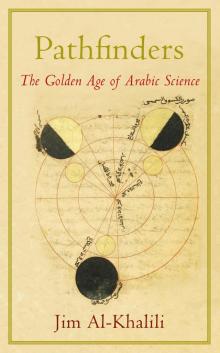- Home
- Jim Al-Khalili
Quantum Mechanics Page 3
Quantum Mechanics Read online
Page 3
Quantum biology – a new science
While physicists and chemists have had almost a century to come to terms with the strange behaviour of the microscopic world of atoms, molecules and their constituents, biology has, by and large, not had to worry about quantum mechanics … until recently, that is.
The past decade has seen the emergence of the new field of quantum biology. Careful experiments are revealing that many of the weirder features of the quantum world, like tunnelling, superposition and entanglement, seem to be playing a crucial role inside living cells.
For example the way sunlight is transported through plant and bacteria cells in photosynthesis seems to rely on quantum superposition, in which the energy follows all routes at once; and enzymes, those complex molecules that help life do what it does, are getting a helping hand from quantum tunnelling. It may even be that our sense of smell, the way some animals navigate during migration or how certain mutations in DNA take place all require quantum explanations if they are to be understood.
Quantum biology is still in its infancy and many scientists remain sceptical: physicists find biology messy and complicated while many biologists find quantum mechanics too mathematical and far removed from their subject. However, while the experiments are difficult and the theoretical work complex, it’s an exciting emerging field that’s rich with potential.
But what does it all mean?
Niels Bohr supposedly stated, ‘If you are not astonished by quantum mechanics then you haven’t understood it.’ However, the mathematical part of the theory is extraordinarily powerful and accurately describes the microscopic world – it is the world it describes that is astonishing. The uniqueness of quantum mechanics as a scientific theory is that it permits the interpretation of events in many different ways.
The traditional Copenhagen view developed by the theory’s founding fathers is not so much an interpretation as a philosophical stance. It states that we can never ‘know’ what is going on in the quantum world when we are not looking. All we can do is predict what we will find when we do look. Many physicists agree, since they don’t then have to worry about what is actually going on, arguing that such issues are metaphysical and best left to philosophers.
Another is the many worlds interpretation, which is either the most extravagant explanation or the simplest, depending on whether you like it or not. It states that whenever we observe a particle in a superposition we do not force it to ‘make up its mind’, we simply observe one of the options in our universe, but our counterparts in a parallel reality see another.
There are many other interpretations, each having advantages and disadvantages. Which is the correct one, we don’t yet know, since no current experiment is able to discriminate between them. We may never know the answer.
Quantum gravity – a theory of everything
So, what of the future? Physicists have long wanted to unify the four forces of nature: gravity, electromagnetism and the strong and weak nuclear forces in a single ‘theory of everything’. Newton led the way by showing that the force causing the apple to fall also keeps the Earth in orbit around the Sun. Later, Maxwell showed that electric and magnetic forces are really the same thing. Today, three of the four forces have come under the umbrella of quantum mechanics. The odd one out is gravity, which is described by Einstein’s general theory of relativity.
The much hyped but elusive theory of everything would bring quantum mechanics and general relativity together into a theory of quantum gravity. Such a theory would describe all matter and all the forces in the universe. But we are still searching for it.
Stephen Hawking took a bold step towards such a theory with a proposal requiring both quantum mechanics and general relativity. He suggested that black holes radiate quantum particles from just outside their event horizons. Such ‘Hawking radiation’ has yet to be observed.
Quantum mechanics can be astonishing; it can be profound and it has altered our perception of the world. We’ve come a very long way since those days over a century ago when quantum theory first gave the lie to the claims that science had only a few ‘t’s to cross and ‘i’s to dot; but what is more exciting is that we’ve still got a long way to go.
Further reading
Jim Al-Khalili Quantum: A Guide for the Perplexed (Weidenfeld & Nicolson, 2012)
Jim Al-Khalili and Johnjoe McFadden Life on the Edge: The Coming of Age of Quantum Biology (Black Swan, 2015)
Jim Baggott The Quantum Story: A History in 40 Moments (Oxford University Press, 2011)
Jon Butterworth Smashing Physics (Headline, 2015)
Sean Carroll The Particle at the End of the Universe (Oneworld Publications, 2013)
Brian Cox and Jeff Forshaw The Quantum Universe: Everything that Can Happen Does Happen (Penguin, 2012)
Richard P. Feynman and A. Zee QED: The Strange Theory of Light and Matter (Princeton University Press, 2006)
John Gribbin Computing with Quantum Cats: From Colossus to Qubits (Bantam Press, 2014)
Steven Holzner Quantum Physics for Dummies (John Wiley & Sons, 2009)
J. P. McEvoy and Oscar Zarate Introducing Quantum Theory: A Graphic Guide (Icon Books, 2003)
Chad Orzel How to Teach Quantum Physics to Your Dog (Oneworld Publications, 2010)
Carlo Rovelli Reality Is Not What It Seems: The Journey to Quantum Gravity (Allen Lane, 2016)
MICHAEL JOSEPH
UK | USA | Canada | Ireland | Australia
India | New Zealand | South Africa
Michael Joseph is part of the Penguin Random House group of companies whose addresses can be found at global.penguinrandomhouse.com
First published 2017
Text copyright © Jim Al-Khalili, 2017
All images copyright © Ladybird Books Ltd, 2017
The moral right of the author has been asserted
ISBN: 978-1-405-92944-8

 Sunfall
Sunfall Quantum Mechanics
Quantum Mechanics Pathfinders
Pathfinders